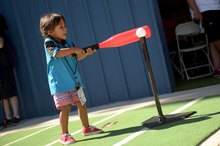Early Signs of Cerebral Palsy in Infants
Cerebral palsy describes a neurological disorder in which damage to the brain affects the ability to control muscles and coordinate movement. Most cases of cerebral palsy are classified as congenital, meaning present at birth, caused by brain damage sustained during fetal development or delivery. Acquired cerebral palsy occurs from brain damage caused by infections or injury during the first few months or years of life. Although present at birth, signs of cerebral palsy may be difficult to detect, especially in mild cases, but most cases are diagnosed by the age of 1 or 2 years, according to MayoClinic.com.
Delayed Development
Infants with cerebral palsy exhibit developmental delays. Some fail to reach major milestones, such as rolling over, sitting up or crawling during the time frames specified by pediatricians. Although all children develop at their own pace, the inability to control the head or lift the chest up while lying on the stomach, by 5 months of age, may indicate cerebral palsy, according to the Pennsylvania Child Welfare Training Program. In addition, the inability to reach for, or transfer, objects from one hand to the other by 7 months of age may indicate cerebral palsy.
Some children may seem to reach developmental milestones on time, but may exhibit abnormal patterns while mastering the new skills. For example, an infant who uses only one hand when playing with a toy, or if her hand trembles while reaching for a toy, may suffer from cerebral palsy. Infants who use their hands and arms well, but drag their legs may show signs of cerebral palsy. Others learn to walk on schedule, but may walk on their tip toes, which is a sign of cerebral palsy.
- Infants with cerebral palsy exhibit developmental delays.
- Although all children develop at their own pace, the inability to control the head or lift the chest up while lying on the stomach, by 5 months of age, may indicate cerebral palsy, according to the Pennsylvania Child Welfare Training Program.
Hypotonia
Activities to Promote Perceptual & Motor Skills
Learn More
Infants with cerebral palsy may exhibit hypotonia, a significant loss of muscle tone. Hypotonia makes the muscles appear loose or floppy. Hypotonia contributes to the inability to control the head and other signs of delayed development.
Hypertonia
Cerebral palsy also causes hypertonia, which is an excessive degree of muscle tone. Infants displaying hypertonia have tight and stiff muscles that constrict movement. Signs of hypertonia include keeping the hands fisted, keeping the legs extended and crossing the legs or ankles. In addition, those infants who kick both legs in unison, instead of one at a time, may exhibit signs of cerebral palsy. Difficulty changing a diaper due to hips that are tight, making it difficult to separate the legs, is a sign of hypertonia and cerebral palsy. Hypertonia also affects the tongue, causing tongue thrusts and excessive drooling.
- Cerebral palsy also causes hypertonia, which is an excessive degree of muscle tone.
- Hypertonia also affects the tongue, causing tongue thrusts and excessive drooling.
Related Articles
References
- MayoClinic.com: Cerebral Palsy
- Cerebral Palsy. Cleveland Clinic. July 7, 2014.
- Al-Mayahi AA. Early Markers for Cerebral Palsy. Cerebral Palsy - Clinical and Therapeutic Aspects. November 2018. doi:10.5772/intechopen.79466.
- Agarwal A, Verma I. Cerebral palsy in children: An overview. J Clin Orthop Trauma. 2012;3(2):77-81. doi:10.1016/j.jcot.2012.09.001
- Nordberg A, Miniscalco C, Lohmander A. Consonant production and overall speech characteristics in school-aged children with cerebral palsy and speech impairment. Int J Speech Lang Pathol. 2014;16(4):386-95. doi:10.3109/17549507.2014.917440
- Chorna O, Heathcock J, Key A, et al. Early childhood constraint therapy for sensory/motor impairment in cerebral palsy: a randomised clinical trial protocol. BMJ Open. 2015;5(12):e010212. doi:10.1136/bmjopen-2015-010212
- What is Cerebral Palsy? | CDC. Centers for Disease Control and Prevention. Apr 30, 2019.
- Cremer N, Hurvitz EA, Peterson MD. Multimorbidity in Middle-Aged Adults with Cerebral Palsy. Am J Med. 2017;130(6):744.e9-744.e15. doi:10.1016/j.amjmed.2016.11.044
- Sanivarapu RR, Gibson JG. Aspiration Pneumonia. Treasure Island, Fl: StatPearls Publishing; 2019.
- Urinary Retention. National Institute of Diabetes and Digestive and Kidney Diseases. Aug 1, 2014.
- What are the early signs of cerebral palsy? Eunice Kennedy Shriver National Institute of Child Health and Human Development. Dec 1, 2016.
- Chorna OD, Guzzetta A, Maitre NL, Vision Assessments and Interventions for Infants 0-2 Years at High Risk for Cerebral Palsy: A Systematic Review, Pediatr Neurol. 2017 Nov;76:3-13. doi: 10.1016/j.pediatrneurol.2017.07.011. Epub 2017 Jul 20.
- Cooper MS, Mackay MT, Fahey M, Reddihough D, Reid SM, Williams K, Harvey AS, Seizures in Children With Cerebral Palsy and White Matter Injury,Pediatrics. 2017 Mar;139(3). pii: e20162975. doi: 10.1542/peds.2016-2975. Epub 2017 Feb 16.
- Gulati S, Sondhi V, Cerebral Palsy: An Overview, Indian J Pediatr. 2017 Nov 20. doi: 10.1007/s12098-017-2475-1. [Epub ahead of print]
Writer Bio
Stephanie Chandler is a freelance writer whose master's degree in biomedical science and over 15 years experience in the scientific and pharmaceutical professions provide her with the knowledge to contribute to health topics. Chandler has been writing for corporations and small businesses since 1991. In addition to writing scientific papers and procedures, her articles are published on Overstock.com and other websites.









